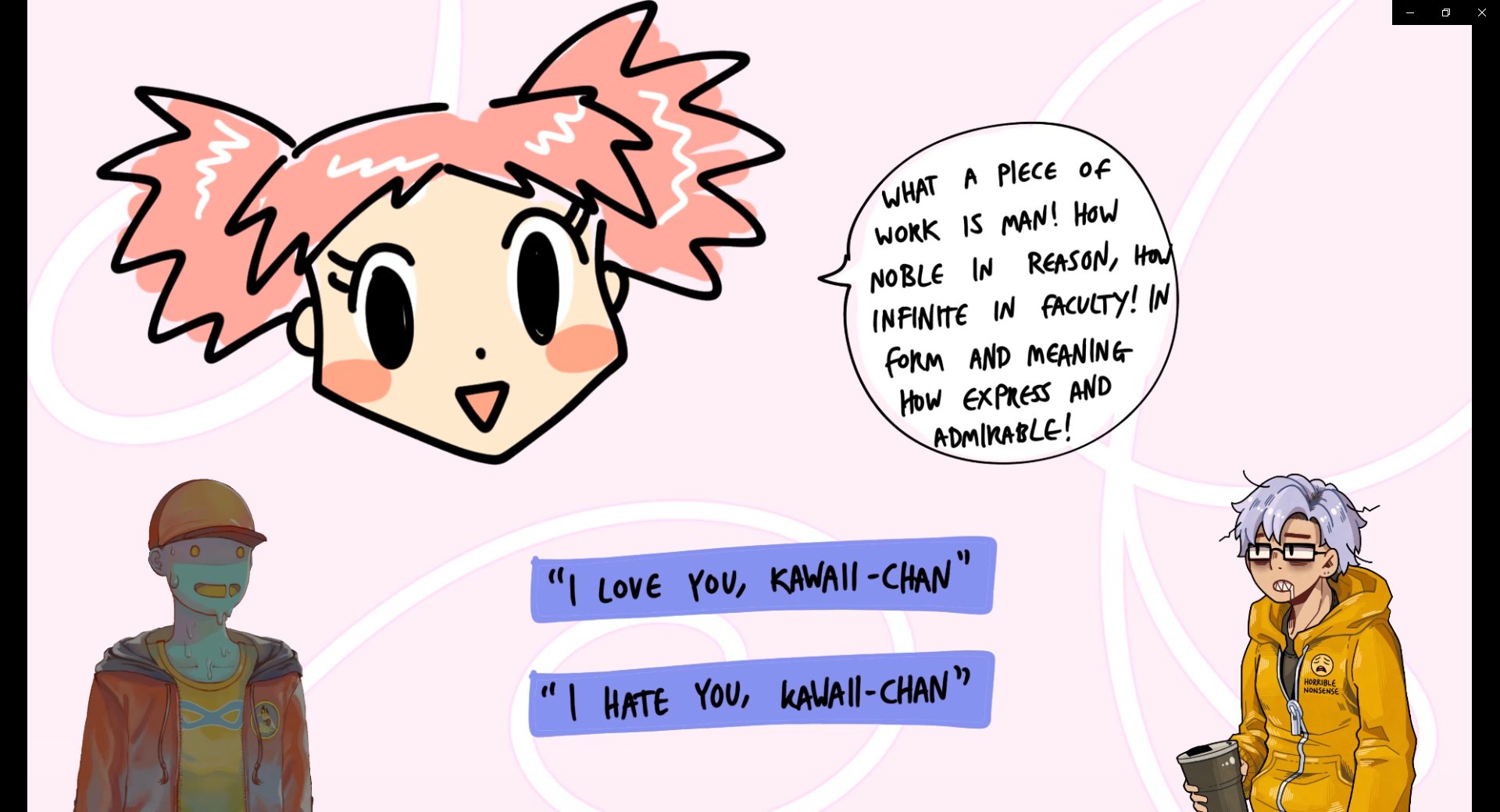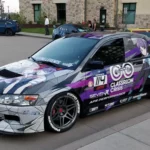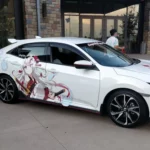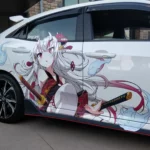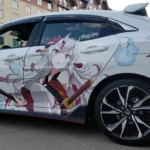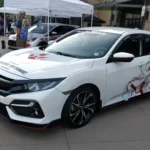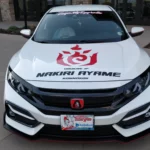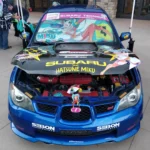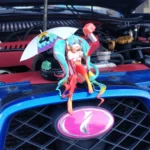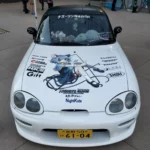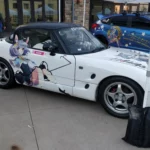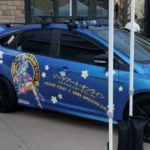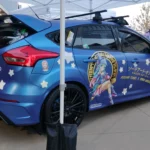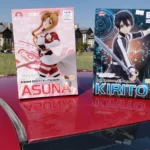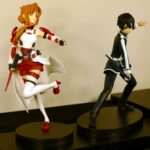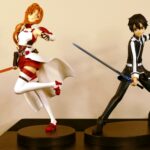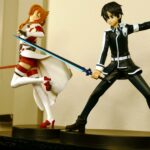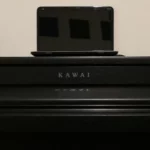In August, against my better judgement, I bought a weekend pass for Nan Desu Kan #24 (2021); and since I already had the ticket, I forced myself to attend last month, September 4th-5th. While I was reluctant to go (even skipping the opening on Friday the 3rd), I ended up having a great time! Read on for my thoughts on this convention and a summary of the events I attended.
Nan Desu Kan describes itself as a “Japanese culture convention” and is organized in cooperation with the Rocky Mountain Anime Association. The name is a pun– the Japanese phrase “nan desu ka?” (何ですか) translates to “what is it?” While the formal description may give the impression of more traditional Japanese culture, the NDK website’s tagline is “The Premier Anime Convention of the Rockies,” and I would definitely describe it as an “anime convention” (or even an “Asian media convention”) more than anything else.
A Parking Fiasco?
The event’s venue was the Gaylord Rockies Resort & Convention Center. While that may sound like a scenic hotel in the mountains, it’s actually just a building in northern Aurora, near the newer housing developments in the Green Valley Ranch area. Because I work near this area, I considered at least stopping by Friday afternoon to pick up my badge, but the main reason I didn’t was the parking situation.
The Gaylord Rockies charges $29/day for parking (according to their website), with pro-rated rates of $8 for less than 4 hours and $18 for 4-8 hours. NDK claimed in a blog post on their website to have secured a special $18.95/day rate for convention attendees. If that all sounds like a lot to keep track of, you might consider parking off-site… but here’s the problem with that:
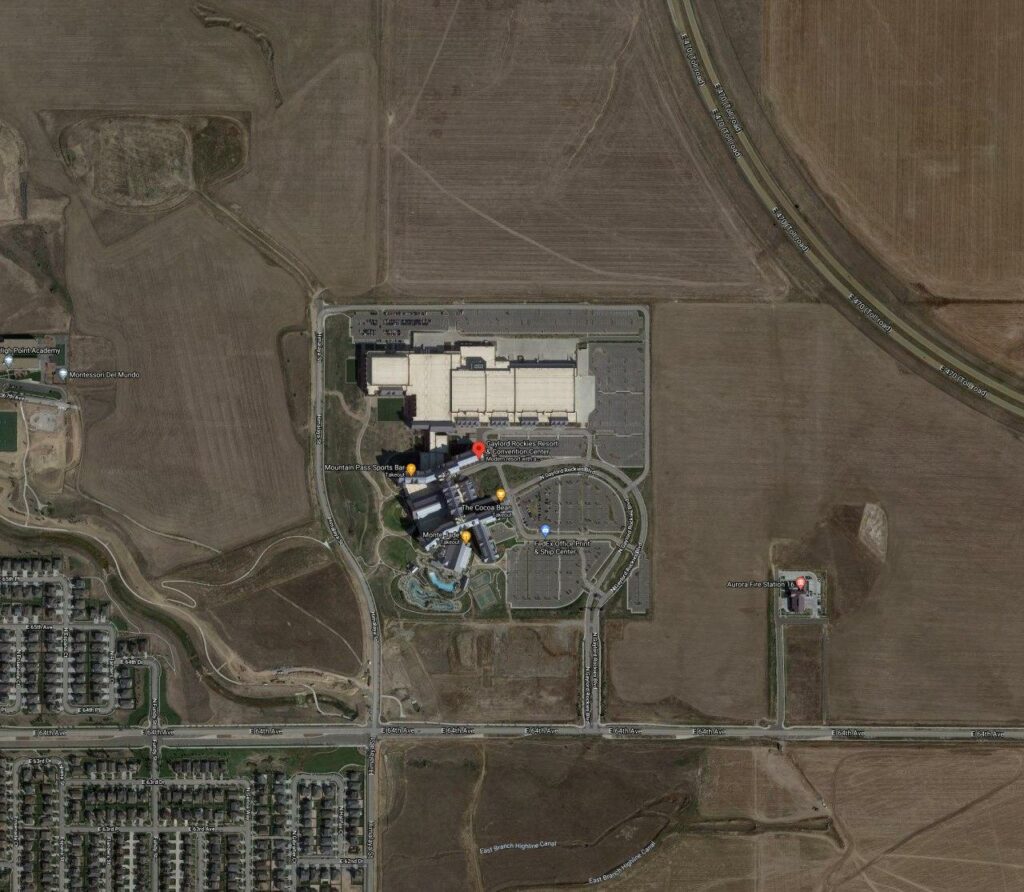
Like many other suburban locations in Colorado, the Green Valley Ranch area seems to get sporadic investment from developers, but then sees lack of interest (probably due to extremely inflated land prices), which leaves large chunks only half-developed. What does this mean for you? If you’re attending a convention at this hotel, there is nowhere off-site to park. The closest parking lot is at a fire station (not for regular use), and the nearby neighborhoods have towing enforcement for their roads, according to NDK.
Fortunately, this was a problem I managed to entirely sidestep, entirely by chance.
- When I arrived on Saturday morning, the hotel’s parking lots were already full, so they were directing non-overnight visitors to park in their front lawn instead– there are no ticketing booths set up in their lawn, so I wasn’t charged for parking there. (I later learned that the lawn filled up, too, but I fortunately wasn’t affected by that.)
- On Sunday, I arrived much earlier, and I did park in one of their paid parking lots (they had the makeshift lawn parking lot blocked off.) But when I was leaving for the day, the exit gate was stuck open, and the pay meter simply said “proceed–” so I got out of there before anyone could ask any questions!
I do think the prospect of a paid parking lot isn’t great for a convention, as both of these workarounds were entirely coincidental, and it’s still an additional $60-90 cost if everything works the way it’s supposed to. Some of the convention’s guests of honor mentioned they would be speaking with the board of directors about parking improvements for next year, so hopefully they can work something more reasonable out by then.
Saturday Panels: Webtoon Revolution (11am-12pm)
With parking out of the way, let’s jump into panels and events. The event schedule wasn’t published until after preregistration was closed, and I was honestly underwhelmed upon seeing the selection of panels. However, it ended up working out, largely because I threw my tentative plans to the wind and just went to things that sounded cool in the spur of the moment. Every single panel I saw on Saturday can be described like this: “It wasn’t what I was expecting, but it was still cool!”
The first panel I attended was entitled “Webtoon Revolution,” and the description in the program guide made it sound like it would be discussing the webtoon format and the reasons for its rise in popularity with anime fans. It actually ended up being a couple of girls talking mostly about some specific webtoons that they enjoyed (the only title I remember from the panel is True Beauty).
Most of the panels (at least the ones in the smaller breakout meeting rooms) ended up being like this: rather than industry professionals, it was hobbyists interested in sharing the topic with others. It ended up working well– while the presentations weren’t very polished, it was great to hear peoples’ enthusiasm and passion about the things they’re interested in.
Despite the casual nature of the panel, I did learn some things: while I had assumed webtoons were just an electronic alternative to manga, they’re actually a South Korean media (with manga being primarily Japanese.) And while manga is often adapted into anime, webtoons are more often adapted into live-action K-dramas. I didn’t jot down the social media info for the two girls giving the panel, but it appears they’re from a Colorado-based K-pop fan group called KonnectPop.
Saturday Panels: Visual Novel Development for Beginners (1:30pm-2:30pm)
The next scheduled panel I wanted to go to wasn’t for another few hours, so I explored the convention layout for a while before finding my next event. NDK had two “video rooms” running for the length of the entire convention, usually playing dubbed anime. The schedule was posted on the video room doors, but wasn’t published online (suggesting possible licensing issues for the anime being shown), so I stopped by a couple of times just to see what was running. I ended up finding the perfect thing to watch– a video panel entitled “Visual Novel Development for Beginners: Where to Start and How to Make it to the Finish!”
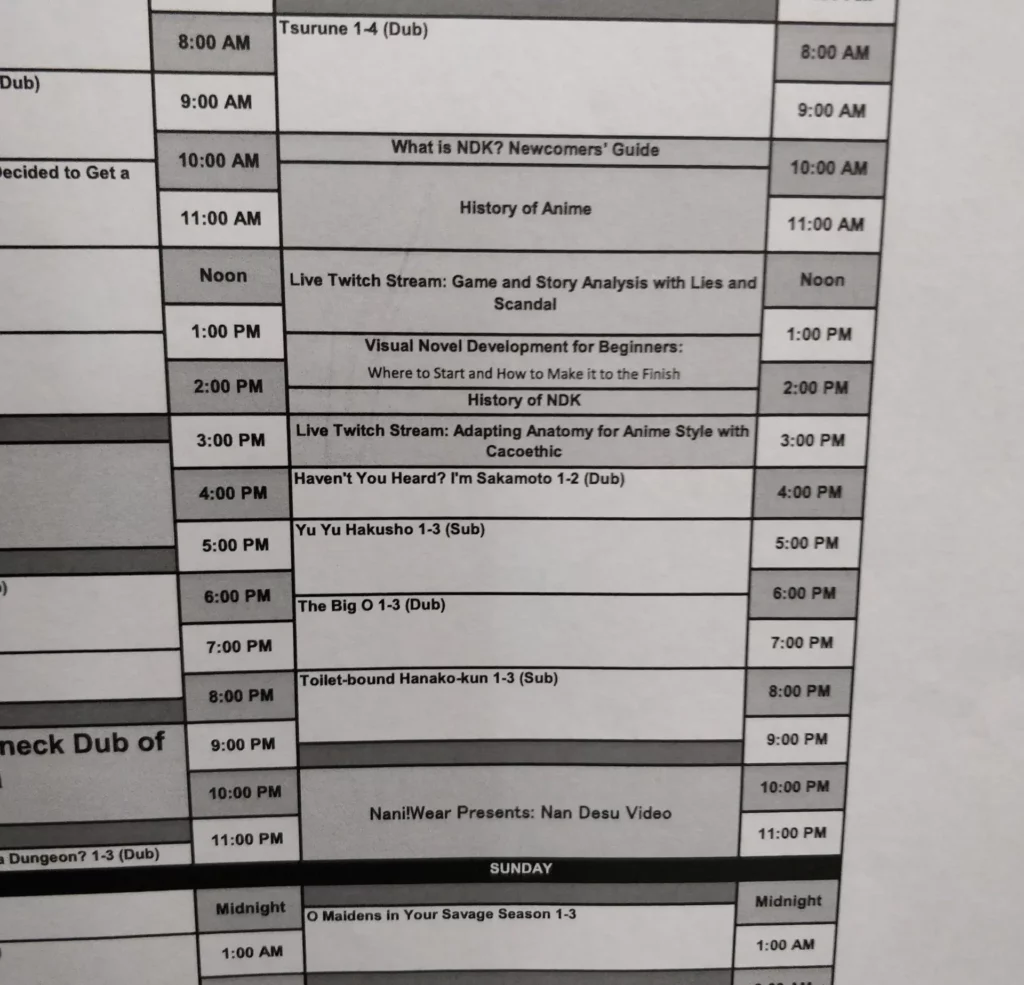
I stumbled into this panel with perfect timing, about one minute before it started. Being a visual novel fan, and having produced music for a VN in the past, I’m always interested to hear other peoples’ thoughts on the medium and the perspectives of people who have made their own games. The panel didn’t include any mind-blowing secrets, but it was a very nice presentation covering ways to integrate all aspects of a VN, like writing, artwork, music, and programming, and tips for finding free resources for the areas where a team might be lacking.
I’m not sure why the two-person team decided to make a video presentation instead of doing an in-person panel, but it might have been because the video format allowed a much more polished and scripted presentation accompanied by dynamic visuals. Whatever the reason, the presentation was very engaging, and I’d be interested in playing one of the group’s games in the future. I once again neglected to write down their info, but I found them on Twitter promoting the panel.
In addition @inktrashing and I, collectively @inkethic, have a pre-recorded video at @NanDesuKan called “Visual Novel Development for Beginners: Where to Start, & How to Make it to the Finish!” We focus on workflow and organisation for teams & individuals! pic.twitter.com/6mR8s2jZKY
— Cacoethic 〓〓💦 (@cacoethicart) September 3, 2021
Saturday Panels: Preparing for Your First Trip to Japan (3pm-4pm)
The third panel I went to was “Preparing for Your First Trip to Japan w/ Kevin McKeever,” presented by one of NDK’s guests of honor. The guest isn’t one that I’d heard of, although he’s apparently a marketing director at Harmony Gold, a US-based production company behind the Robotech anime franchise. When I went to pick up my number card for the panel’s line, the NDK volunteer working at the table told me I was in for a treat with Kevin’s presentation style.
I was more interested in the panel simply because I’ve never been to Japan before, but am planning to visit once COVID restrictions ease up, so I was hoping it might talk about some of the sights to see and some of the tourist traps to avoid. Unfortunately, it didn’t end up quite being that, although (true to form for the weekend) it still ended up being entertaining. Mr. McKeever was definitely more of a professional presenter than any of the community-organized panels that I went to, showing no hesitation during his slideshow and handling questions authoritatively.
However, the actual content of the panel ended up being more about general travel tips– packing well in advance, getting to the airport early, and not causing any trouble in the security line. The most Japan-specific topics that were addressed were prescription medications that are legal in the US but illegal in Japan, and while I did learn some things about the benefit of purchasing travel insurance, I didn’t necessarily need to be told that standing in the airport makes sitting through a long flight easier.
While the panel was disappointing from an information perspective in retrospect, it was actually very entertaining at the time (owing to Kevin McKeever’s presentation style), so I decided then that I’d check out another one of his panels the following day.
Saturday Panels: What are Anime Fashion Dolls? (5:30pm-7pm)
But for Saturday, I still had plenty of time to kill. Looking at the schedule, there wasn’t much that caught my eye for this time block. I considered going to a panel by Major Attaway, another convention guest and an English dub voice actor for anime, but having learned the general format of these panels and the level of information that I could expect, I made an off-the-cuff decision to check out “What are Anime Fashion Dolls?” instead, assuming “anime fashion dolls” were a fancy term for figures or figurines.
At conventions, I’m used to getting to panels very early. I picked that habit up from RTX, where getting in line 45 minutes early instead of 30 minutes early can make or break being able to see a panel. NDK was actually much less line-heavy, and I was usually one of the first ones waiting for panels. For this one, after picking up my line number card, I didn’t see a clear line anywhere, but I saw a small group walk towards the panel room door and stand outside of it, so I stood next to them, thinking they looked like they knew what they were doing.
A few minutes later, most of the group left, telling the girl who remained to “have fun at the panel!” I never got the girl’s name (I really wasn’t focused on gathering info during this convention, was I?), but after standing in the panel room hallway for a few more minutes, both of us started to realize that we were in the wrong place. After sharing some confused looks, I spoke up first, and we went back outside to the actual lineup area.
The girl was wearing a cosplay outfit of a character I didn’t recognize. The character had bobbed, jet-black hair. I asked, “so, is your hair dyed?” to which she responded, “oh, no, this is a wig.” That was understandable. She then followed up with, “I actually don’t have any hair under this– my head’s shaved.” I said “oh” and rolled past it, but it was definitely the strangest interaction I had all weekend (which is actually a good thing.)
She then turned the tables on me by asking, “so, are you into anime fashion dolls?” I replied something along the lines of, “oh, not in particular, I was just looking for a panel to go to and it caught my eye. I figured they’re similar to figures, right?” The look on her face informed me that my assumption was wrong, and she let me know that they’re actually a completely different thing.
As I learned in the panel, “anime fashion doll” is a term for a style of ball-jointed doll— a poseable, dressable toy, as opposed to a static figure– that uses anime-like proportions for the body and face, but has ultra-realistic skin and hair. Rather than being based on anime characters, fashion dolls have their own set of characters within the industry, or some people just create their own.
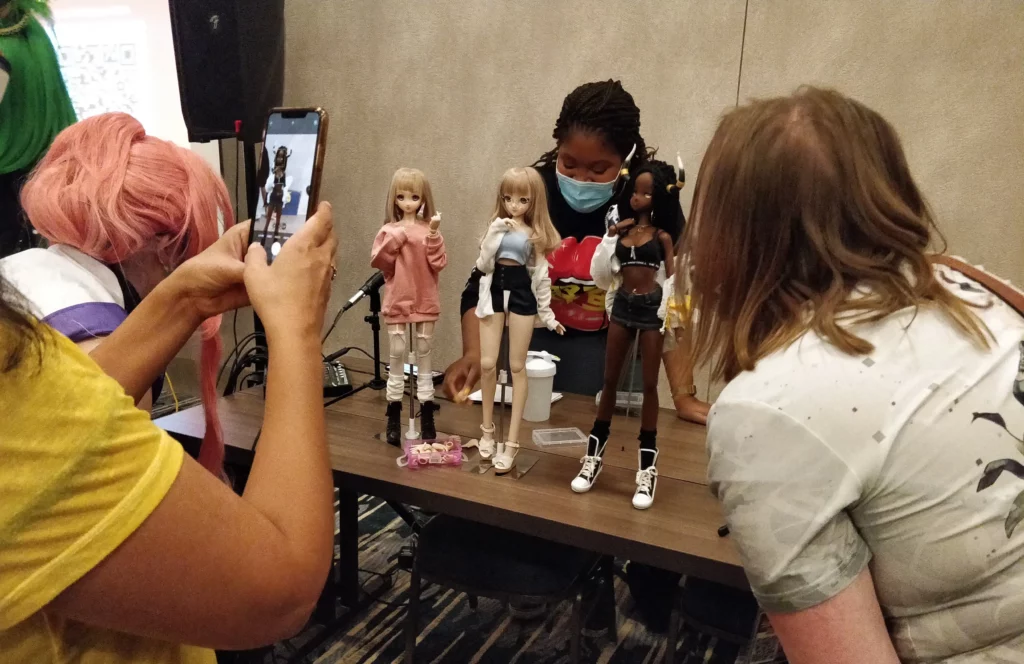
Lots of care goes into building and maintaining these dolls. They’re easy to damage, and the skin can even be stained by dye from the hair or clothes if the right precautions aren’t taken.
The panelist covered three major distributors of the dolls, pointed out pros and cons of each type, and discussed how purchasing works in first-hand and second-hand markets. My temporary panel line friend leaned over to whisper details about the ones that she had at home.
To my surprise, this panel was the sparsest-populated one that I attended all weekend, with literally a handful of people in the room (although several others weren’t much more crowded, either.) The panelist finished her presentation nearly an hour early, not using anywhere close to the 90-minute time block she’d secured on the schedule.
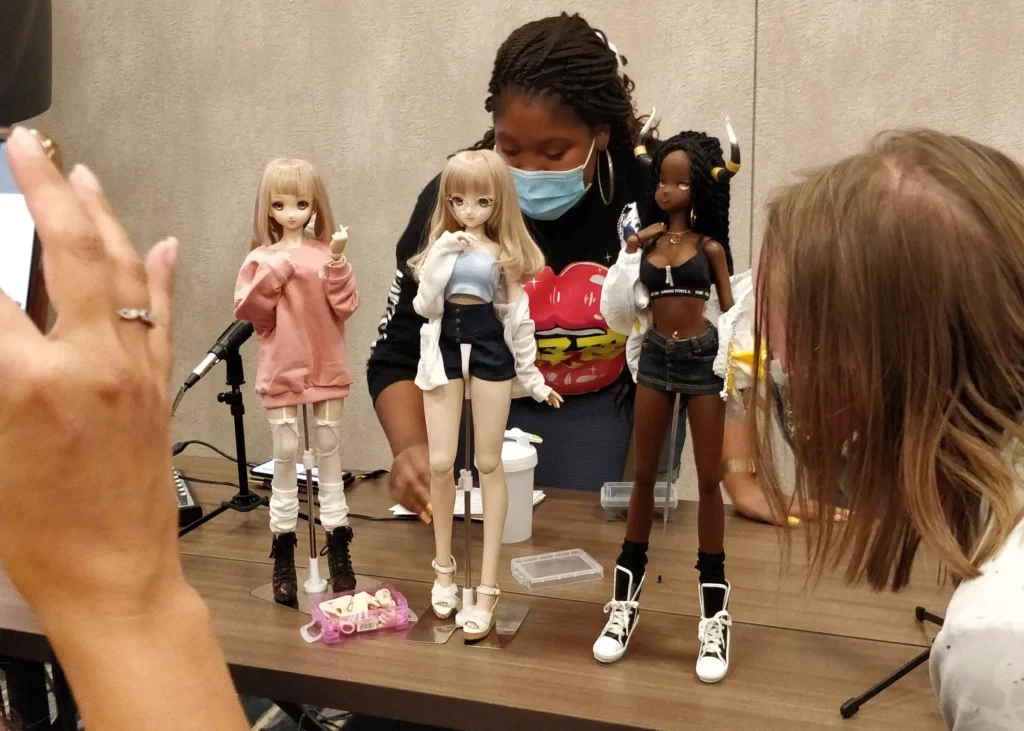
For this panel, I did manage to grab a photo of the last slide of the presentation, which leads to a Google doc with information for vinyl anime doll beginners. Using the doc’s metadata, I also found the presenter on Pinterest and Esty, if you’re interested in seeing more of these.

Saturday: Convention Atmosphere (Car Show & Arcade)
After my panel buddy and I went our separate ways, I had several hours to kill before the last panel of the day. I spent the time walking around, taking in all the different cosplays, browsing merchandise (which I’ll detail later), and generally hanging out at the convention.
I was seriously concerned about going to a convention by myself, but the atmosphere was very comfortable, and even energizing. Anime fans (at least the sensible ones) know that anime isn’t something you generally talk about at work, school, or other public locations. As Doki Doki Literature Club put it, it’s “one of those things where you can’t really admit you’re into it until you know where the other person stands.” Over the last few years, as my interest in anime culture has grown, I’ve been fairly open about including mentions and references in my videos, but it’s still not a hobby I generally telegraph.
For that reason, it was extremely refreshing to be in a convention full of people who are into anime. Not everybody’s a fan of the same shows or genres, but everyone has some awareness of the various mediums (anime, manga, VNs, J-pop, etc.), and nobody’s judging anyone for being into that one show or dressing up as that one character. As NDK convention host Jeremy Pieta put it, it’s a place where anime fans can say “this is something that I like.”
The convention center hallways were relatively peaceful, but outside the building, a car show was taking place with J-pop music and plenty of space to sit down and rest. I’m not particularly into cars, but here are some of the better photos I grabbed (click to view):
Once it got darker outside, I spent some time lurking in the video game room, although I didn’t attempt to play anything myself. A PlayStation fighting game tournament was going on at a large projector screen on the back wall. In one corner of the room, a physical Mario Kart recreation with RC cars and wireless cameras was running; in another corner, original Japanese Mario Kart arcade machines were present.
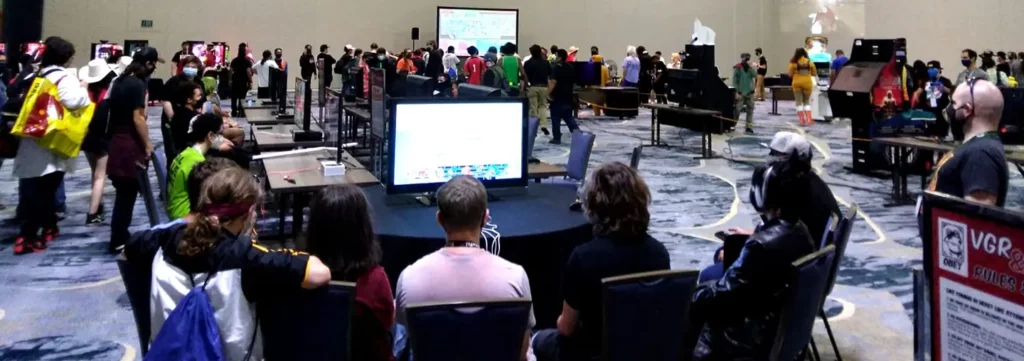
While many of the arcade machines were familiar side-scrolling fighters, there were also lots of rhythm games, a few cooperative first-person shooters, and a very modern mecha game that looked a lot less gimmicky the longer I watched people play it.
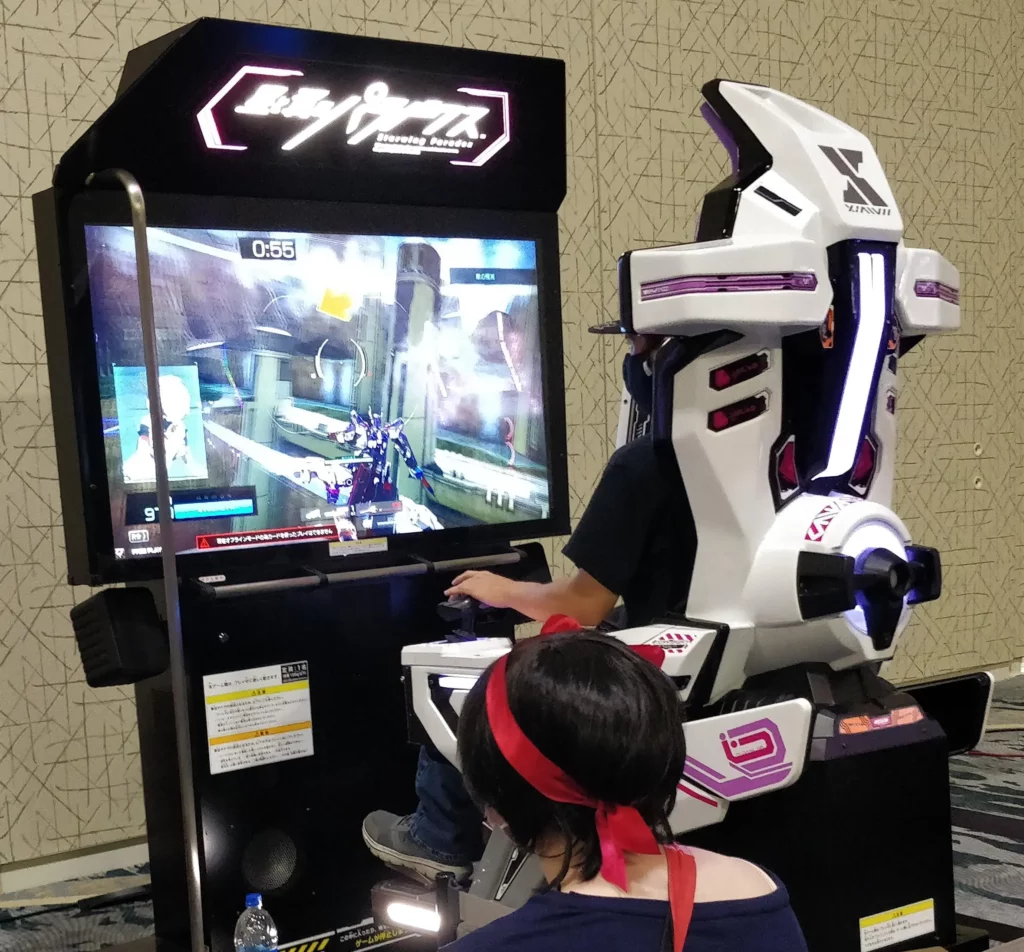
The arcade’s atmosphere was extremely friendly. At an original two-player The House of the Dead cabinet (circa 1996-97) that was a bit less crowded, in accordance with NDK’s “pass the controller” rule, I was asked multiple times by other attendees if I wanted to swap in and play, just from standing a few feet away and watching.
Saturday Panels: It Doesn’t Work Like That Hentai Panel (9pm-10pm)
NDK includes a number of “night life” events, including karaoke, a rave, and a burlesque show. None of those quite suited my comfort level, so I picked a (relatively) late-night panel to go to instead.
Waiting in line for a hentai panel was an interesting experience. I mentioned earlier that most panels had very few attendees and very casual lines. This panel was the exception to that rule. In fact, it was the only panel I went to the entire weekend that actually filled every chair in the room.
The line was split into a block, and I happened to be on a corner of the block. At one point, some convention-goers emerged from a nearby staircase and, wondering what the commotion was all about, asked me what I was waiting in line for. Not even phased due to the sheer number of others waiting in line with me, I responded: “this is the ‘It Doesn’t Work Like That Hentai Panel.'” “Oh,” the lady responded. She walked back over to her two companions and explained, “they’re waiting in line for the hentai panel.” “Oh,” her companions responded.
Like the rest of the panels I attended, I honestly had no idea what to expect from this one. The program guide’s description said:
There are many unrealistic things in hentai, and some of them are actually more surprising than you might think. Come see why if these actions were performed in real life, they would either be impossible, or lead to death.
My money was split 50/50 between a lighthearted panel using this analysis as an excuse to show hentai, or a more serious attempt to deride hentai for being unrealistic.
Upon entering the room, my first surprise was that the projector was powered off. Apparently, NDK doesn’t allow showing hentai, even at 18+ panels like this one where photo ID was required to enter. At the table in the front of the room was a single man. I started to wonder… how is one person going to entertain over a hundred spectators on the topic of hentai without any visual aid?
It turns out, that man knew exactly what he was doing. The panel ended up starting about fifteen minutes late due to NDK personnel making sure every possible seat was filled, since attendance was capped. (It almost seemed intentional how long they took to do this.) But once it did start, it ended up being something more akin to a stand-up comedy show, only the person delivering the jokes was sitting down, and the jokes were colorful descriptions of some very unrealistic hentai.
I wasn’t the only one who was caught off-guard. Minutes after the panel started, some audience members began to leave. By the end of the panel, I’d estimate at least a third of the room was already gone, maybe even half. But for those of us who stuck around, it was certainly funny. The panelist owned the material, giving verbal descriptions that weren’t uncomfortable so much as increasingly bizarre. It may not sound like much, but when you hear a six-minute detail of acts so obscene that even the presenter questions why he was watching it, followed by “…and then episode three rolled around,” you might find yourself laughing.
The one criticism I had of this panel was that some of the jokes and descriptions did get repetitive, which is completely understandable. After all, there’s only so many ways you can say “that wouldn’t fit there” before it all starts to blend together. At the end of the panel, the panelist announced that he was actually holding his main panel, “JoJo’s Crazy Noisy Bizarre Panel,” the following day. While I didn’t end up attending that one (I’m not a JoJo fan), I absolutely respect someone putting themselves out there in a performance like this essentially as a form of advertisement.
With that, I retrieved my car from the hotel’s lawn, picked up a pizza on the way home, and set an alarm to get an early start for the final day of the convention.
Sunday Panels: Otaku’s Guide to Job Hunting (10am-11am)
The panels I went to on Sunday were more professionally-oriented, starting with one about job hunting. I was thinking this one might be geared toward finding a job within the anime/manga industries, but it turned out to be more of a general “tips for finding a job,” presented by an HR manager who’s also an otaku, and geared toward fellow geeks (who presumably lack social skills that would be helpful when writing a resume and interviewing.)

There were less than ten people in the audience of this panel, at least one of whom was a friend of the presenters (and left halfway through after his phone rang– great friend!) Working in IT, my career is generally more stable than those of artists and voice actors, so I didn’t necessarily have a particular need for this panel. However, my eyes are always open for new ideas and suggestions regarding career development; even if I decide certain advice isn’t applicable to me, it’s still helpful to know what the people I’m competing with might be doing.
One piece of advice that resonated with me was to gamify boring work. It’s not a new concept, and I’d heard it before, but I didn’t realize until this panel that I’d actually done it myself in the past. When the presenter, Kelly from Creativity By Design, asked if anyone had used gamification in their work, I raised my hand– and was surprised when I was called on to share my example! (I thought it was just supposed to be a show of hands.)
My example was from when I was working in a health care company. I’m not passionate about health care; I was just there for the tech. And since health care data is sensitive, I usually never saw any health stuff, I only saw the tech. So I started imagining that I was working in one of those dystopian network systems, like the Sibyl System from Psycho-Pass. When a router went down, I would think to myself, “I have to get that back up so the Dominators work in that area!” The co-presenter, Marcus, was a big Psycho-Pass fan, and he loved my example.
After the panel, I stuck around to ask the presenter how much she pays attention to which specific college is listed on a resume and whether the college is online or in-person, since I’m currently attending an online college for my bachelor’s degree and am considering options for my master’s degree. She said whether it’s online or in-person has no weight, and that whether you feel like you learned anything is more important than which specific school you go to. Obviously, though, this will vary between companies, countries, and cultures– it was more of a data point for me than a definitive answer.
Sunday Panels: How I Broke into the Anime Industry w/ Kevin McKeever (2pm-3pm)
The second-to-last scheduled event I attended was another panel with Kevin McKeever, since I’d been “wowed” by his presentation skills the previous day. Unfortunately, I did find him to be a bit of a one-trick pony, giving another panel with very little actual substance.
The panel started off with Kevin introducing himself and handing out a “collector’s edition” card for a new Robotech media collection– I ended up with two, and he stressed in both panels that it can only be found at conventions.
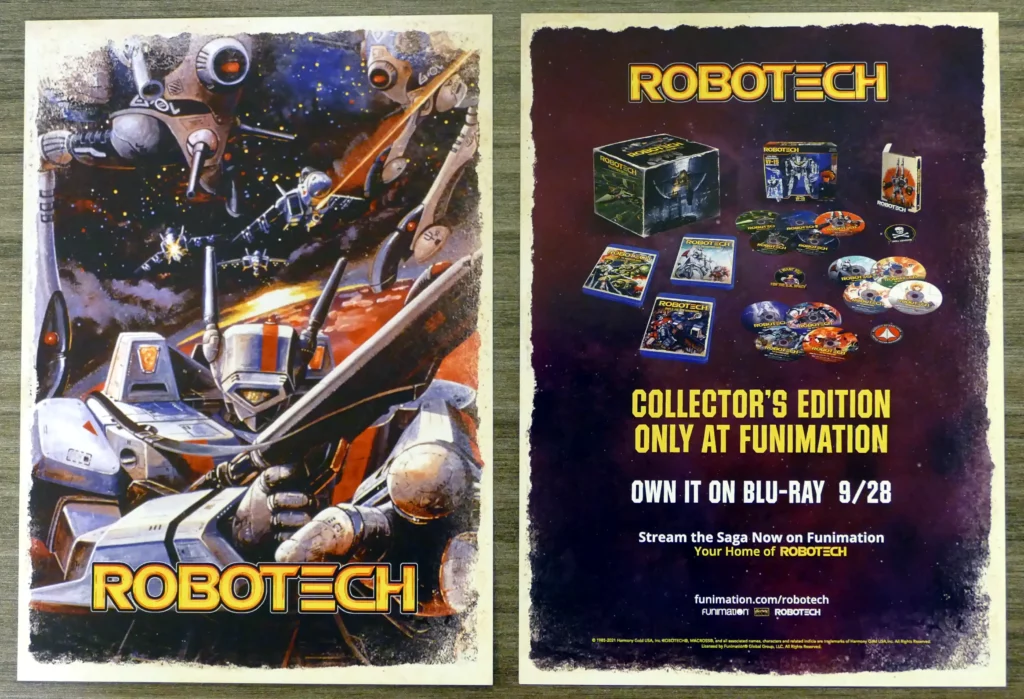
After that, I was hoping to hear about Kevin’s experience working within the anime industry, and specifically what differences there might have been from other industries. Instead, it ended up being a story about how he pulled himself up by the bootstraps, didn’t take “no” for an answer, and worked as an unpaid intern for several years until finally catching a lucky break– within Hollywood. Then, once he was established in the American show business industry, he dressed professionally while attending a convention and approached a Harmony Gold employee offering his services for the Robotech franchise that was being brought back to life.
I don’t mean to discredit Mr. McKeever. He’s a professional within his industry who’s clearly worked hard to achieve his position in marketing. There just wasn’t any information in the panel that was applicable to me that I didn’t already know.
Kevin seemed to avoid talking about the differences between working in movie marketing and actually being an actor or artist, probably because aspiring artists make up a large portion of anime convention attendees. But working in IT, I personally have no fantasies (at least, not anymore) about working in the media industry in a creative capacity. On the contrary, I’ve come to recognize that every artist needs a computer to draw or animate with, every studio needs a network to distribute its content, and every streaming corporation needs servers to physically host its media. For me, IT is a gateway into going where I want, because the skills I have are needed by others– so the plethora of advice for those who don’t have marketable skills aren’t very relevant to me.
The other side of the coin is that Kevin works for an American company, not a Japanese company. I asked a question about how closely Japanese studios work with their American marketing and distribution counterparts, or if they operate entirely separately, and Kevin’s answer wasn’t much more than “it depends on the company.” So while I’m glad he’s proud of his career, and glad that he can entertain people at these panels, I just can’t say I learned much from him.
Sunday: Exhibitors Hall & Artist Alley
With even more hours between some of my panels on Sunday, I had plenty of time to continue wandering the premises, which included checking out the merchandise. When I bought my NDK ticket, I opted not to purchase the official convention T-shirt, instead planning to find myself something nice on the exhibition floor.
When I used to go to RTX, the exhibition floor never excited me much, probably because RTX was video game-themed and I’m not very into video games. In contrast, the NDK exhibition hall, being anime-themed, was one of my favorite parts of the event.
A look at the Nan Desu Kan Exhibit Hall on Friday afternoon.
Posted by Robotech on Friday, September 3, 2021
I can’t overemphasize how much self-control it took to not buy more merch than I did. I told myself going in that I could get one (and only one) thing, and gave myself a maximum amount that it could cost (which I increased slightly after not having to pay for parking on Saturday.)
The merch floor was split up into two sections. The right half of the room was the “Exhibitors Hall,” which had corporate booths with mass-produced merchandise like posters, wall scrolls, DVDs and Blu-rays, hard copy manga, figures, plushies, and clothing. The left half of the hall was “Artists Alley,” which was exclusively independent artists selling limited-run prints of their artwork, plus some crafts like keychains.
I must have walked back and forth between certain booths dozens of times as I tried to pick out something to take home as a souvenir. On the exhibitors side, my eye was first caught by a figure of Asuna from Sword Art Online. That first one was a little more ecchi than I’d want to display in my apartment, and it was also beyond my budget, so I kept looking.
Now that my eye was on Asuna, I found a “noodle stopper” figure of the same character in her classic outfit, for a much more reasonable price. My hesitation with this one was that it’s made to sit on the edge of a shelf (or the lid of a noodle-cooking cup, hence the name), and with all the vibrations from neighbors in my apartment, I knew I’d be eternally worried about the figure falling and breaking.
I eventually found a third Asuna figure being sold with a slightly more niche, but also very decent, outfit (her armor from Season 3 of the show, as opposed to the original version.) Meanwhile, I also stumbled across a booth with matching Asuna and Kirito throw pillows, featuring vibrant colors and a cool hexagon pattern on each.
Over on the artists side, I was also seeing a lot of things that I liked. Due to the release of Doki Doki Literature Club Plus! earlier this year, there was a resurgence in DDLC fan art, and a lot of it made its way to the convention. One piece of fan art that I used in a project earlier this year was at one of the booths, along with the artist who drew it!
I was especially tempted by the Monika portrait being offered. The problem with art prints is that the standard 11″x17″ size is only slightly larger than a regular piece of paper, so it’s too small to display standalone, at least in my apartment where I already have several larger posters and try to keep clutter to a minimum.
As such, I was considering getting four prints (either four portrait or four landscape) to hang in separate frames in a rectangle– that would approach the size of a regular poster. For that reason, I nearly pulled the trigger on the Monika piece along with the Chika and Darkness/Megumin/Aqua pieces at the same booth, but I didn’t find any other really good portrait prints of the same size, so I didn’t have enough to build a complete rectangle.
Another piece of artwork that caught my eye was a watercolor painting of the original Love Live! cast, offered as a sparkle print. The pastel colors almost looked mistakenly light, but the contrast of the background’s shimmering night sky created a magical effect, very fitting for the characters.
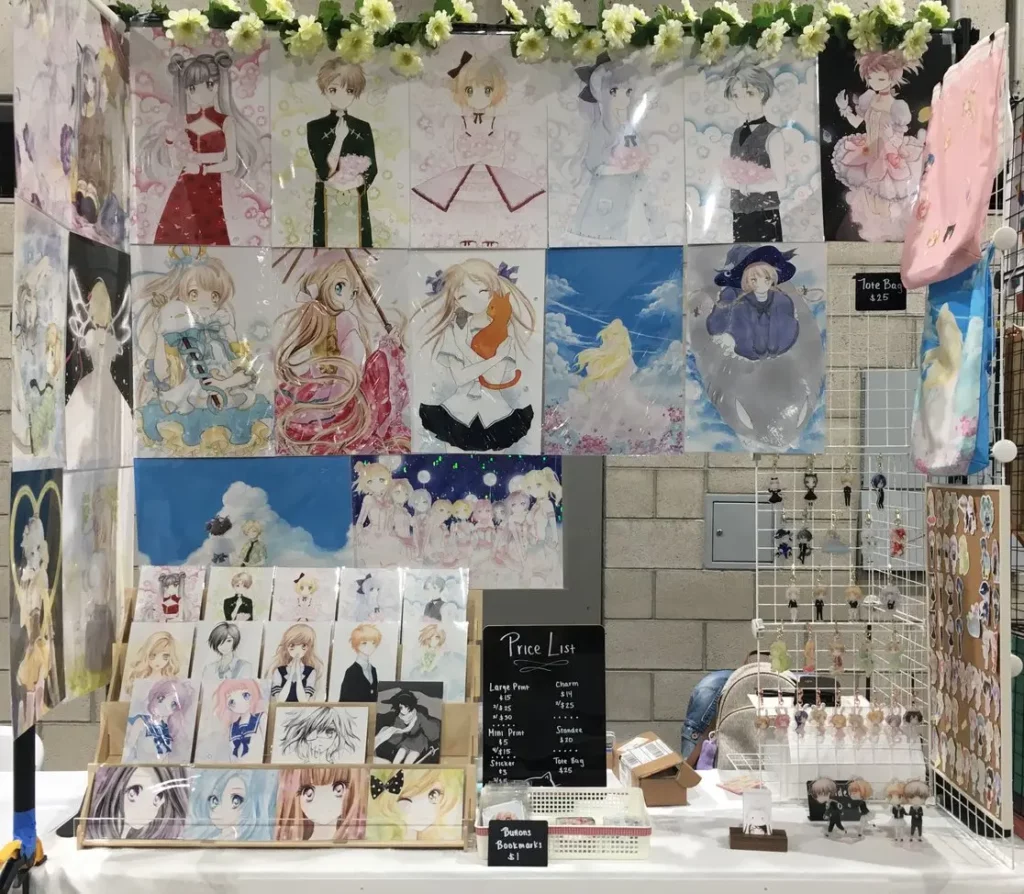
As beautiful as it was, though, there weren’t many other landscape-orientation prints that I was interested in, certainly not the three that I’d need to create a rectangle.
Finally, I considered getting a small poster from a booth with various Hololive artwork– only I couldn’t decide which one I’d want. The characters that I liked more had artwork that was a little busy, while the artwork that I liked more had characters that I recognized, but didn’t know quite as well.
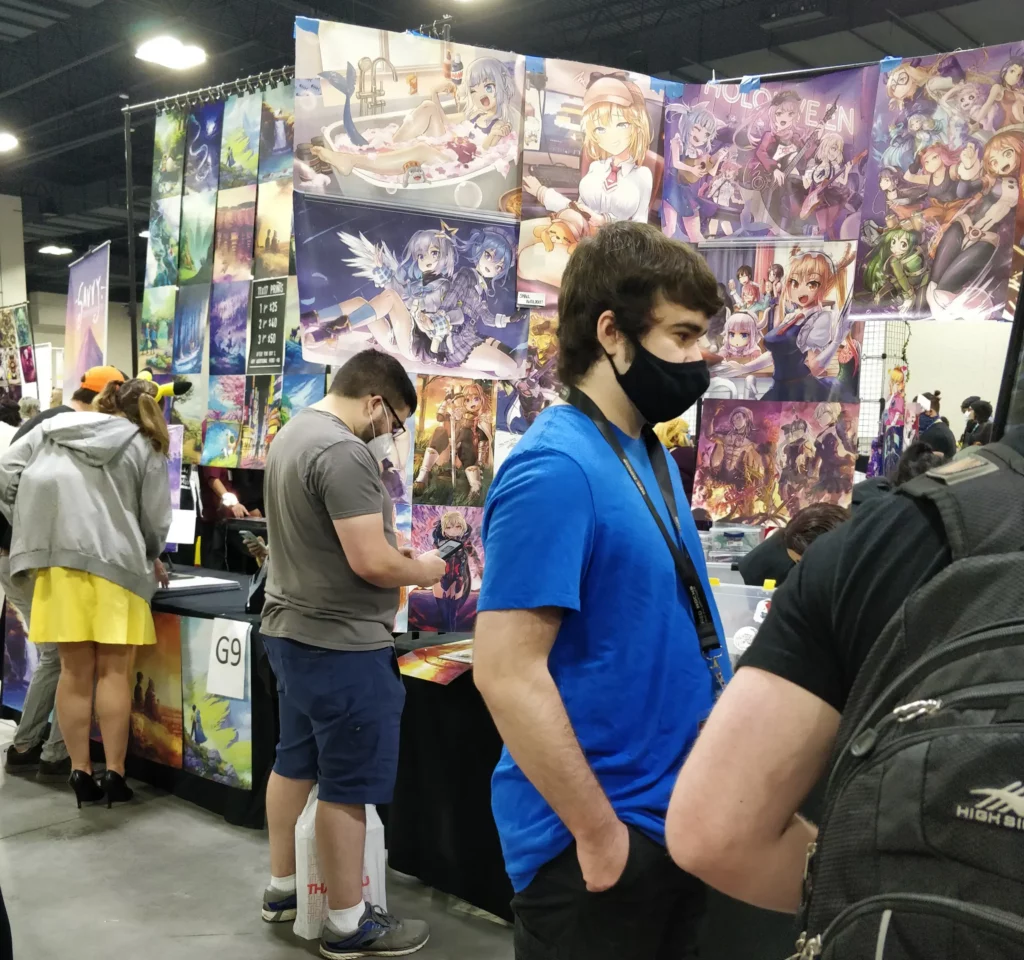
There were plenty more booths, too, each with its own unique art style. Some art was more realistic, some used darker colors, some was more cartoony, some used heavier lines. No matter what your preference in art is, you could probably find a booth selling something you like.
Ultimately, the sheer variety of artists alley ended up being its undoing, at least in my specific case. While there was a ton of stuff that I wanted, I failed to find four matching prints, and the larger posters that I was eyeing had sold out by the time Sunday rolled around. With that, I headed back to the exhibitor’s side.
I ended up noticing that while one booth had the Asuna figure I was considering, another booth had a matching Kirito figure from the same line. The Kirito figure was already cheaper than the Asuna figure, and it went on sale the last day of the convention, bringing the total price for those two figures well into my budget. With that, I made my decision, and my apartment is now adorned with two Sword Art Online figures (click to view):
Sunday Panels: Live Painting Demo w/ Amelie Belcher (4pm-5pm)
By this point, I had already killed many hours walking around the convention between panels, and I seriously considered leaving. However, having had such a good time so far, I decided to stick it out and try attending one more event to fully get my money’s worth out of the tickets. The final panel I decided on was a live painting demo by Amelie Belcher, a guest from Austin, TX who does painting streams on Twitch.
I do want to mention one of the reasons I was hesitant about spending several more hours at the convention waiting for this event: I had done a web search for the artist’s name to see what style of art they’d most likely be demonstrating, and I came across an extremely outdated website with a sensitive political cartoon on the homepage.
I didn’t even realize until weeks later that the post was made in 2013; all I saw at the time was a political cartoon I wasn’t interested in and a description stating the artist “drew this with hands SHAKING with rage.” Based on that first impression, I assumed the artist would bring up politics at some point in any conversation or presentation, and that I wouldn’t enjoy listening to her. Both of those assumptions turned out to be false.
The reason I’m mentioning this is because it demonstrates how important it is not to give off an overly-strong impression with your online media. I usually go out of my way to avoid speaking too much about controversial topics in my public videos for precisely this reason, but I’m also guilty of letting loose on social networks from time to time, and this was a great example of the little ways it can affect the world.
Back to the convention, having decided to risk ending on a low note in exchange for one more event, I walked through the exhibitors hall and artists alley one more time (basically just treating it like a museum by this point.) I then explored a bit more of the hotel/resort grounds, which were extensive enough for me to end up at an employees-only parking lot and have to turn around to get back to the convention. Finally, I made my way to the Art Academy room, which was in a hallway of smaller meeting rooms that also included a model show and art gallery.
When I arrived outside the Art Academy room, the door was adorned by an easel holding a painting of a dark-skinned woman against a night sky background. The previous event, a woodblock printing activity, was still going on. That made sense, since I got there around 3:45. But as the clock ticked closer to 4, nobody else seemed to be waiting in line.
By 4:05, one or two other people had shown up who looked like they might also be waiting for the painting demo… but the woodblock printers were still in the room. By 4:15, one of the woodblock printers finally left. It wasn’t until 4:25 that the woodblock printing event had fully ended, and the five of us waiting for the next event went in.
Come 4:30, halfway through the originally-scheduled time, Amelie Belcher entered the room. I would definitely describer her as a character! She had a large frame, a large personality, and a large Texan accent. She was wearing a mask with a microphone/speaker combo built-in, which I can’t say is the most efficient design in the world, but hey, it worked.
After assuring the previous occupants that she didn’t mind about the woodblock session running long, Amelie grabbed the easel and art piece from outside of the door. I wish I’d taken a photo of it when I had the chance, because it turned out she had started that piece at the previous day’s art demo, and the objective of Sunday’s demo was to finish it!
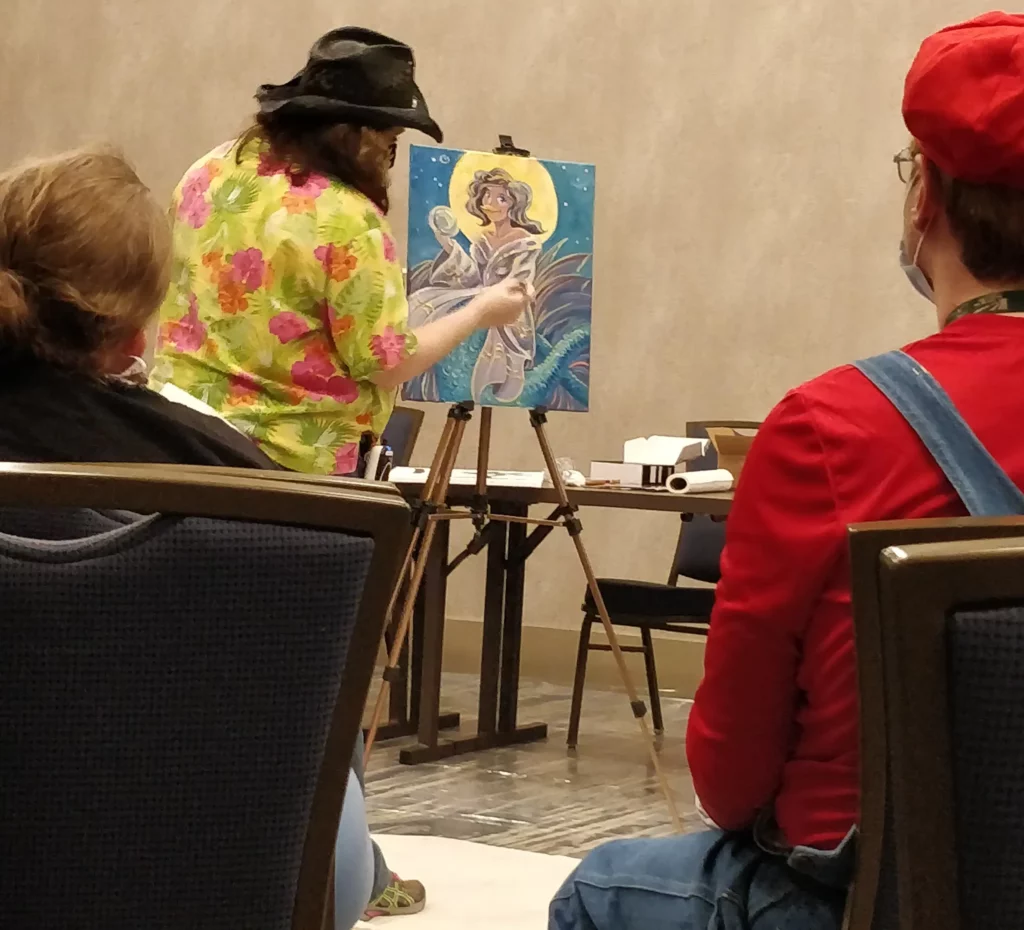
Amelie explained that many newer artists get frustrated when they spend a lot of time learning techniques but can never quite get their art to “come to life” like they want it to– this is something I can relate to in both visual arts and other mediums. As she put it, there are certain “magic tricks” that help finish a work, and those tricks aren’t actually difficult to perform, they’re just non-obvious to those who don’t know what to look for.
While I expected to see a painting started from scratch, I actually had more fun watching Ms. Belcher finish this piece. Just as importantly, I also think that I learned more. It’s easy to go online and find Twitch streams or YouTube videos of artists creating something from scratch, but seeing the finishing touches of color and lighting be put on an existing painting highlighted those “magic tricks” much more clearly.
What impressed me the most about this demonstration was that painting is a non-reversible/destructive medium. I would be terrified to take a fresh layer to a half-decent work that’s already dried! But Amelie had a gung-ho, no-stress attitude about everything she did, even after making mistakes. “Am I worried about it? No!”
In fact, her ability to correct a painting mistake where I would have started over with a blank canvas reminded me of my own ability to correct a Linux mistake where a novice would have done a clean install. I guess that says something about both her level of skill as an artist and how seriously I take my systems administration.
The woman in the painting is Amabie, a legendary Japanese yokai (supernatural spirit) associated with the warning of and protection against pandemics. Amabie (or “the amabie” as it’s more traditionally known) was also NDK’s mascot for this year, printed in the program guide and on signs throughout the convention reminding visitors to follow COVID safety precautions.
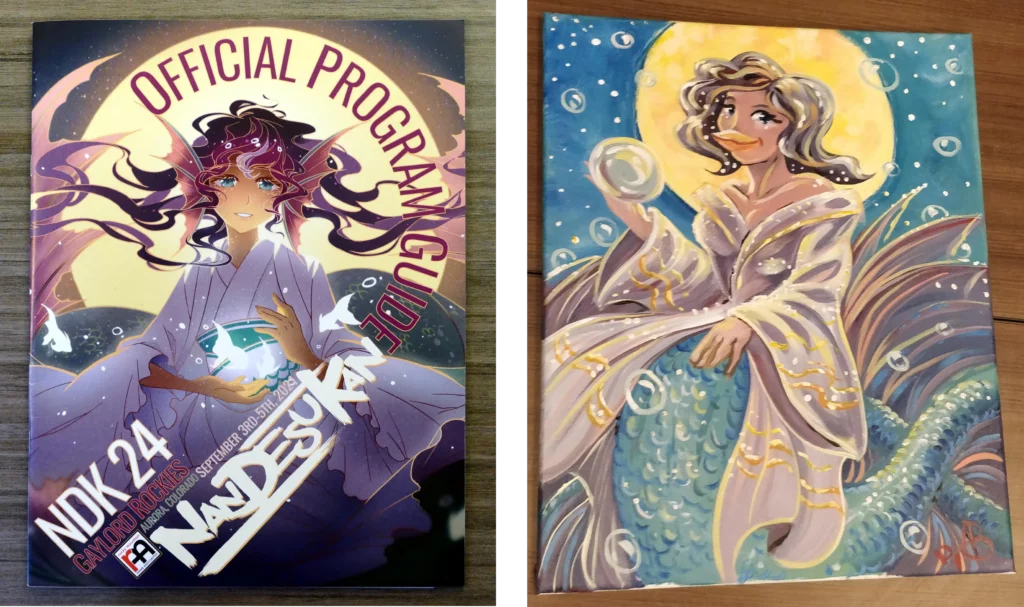
In the original drawings of old, the creature looks almost nothing like a human, consisting of a bird’s head, a scale-covered body, and three legs. Some artists have personified the creature further, leading to the rendition on the cover of the program guide. Amelie initially drew her version much more human-like above the waist, keeping all aquatic features farther down, but she decided after thinking it over on Sunday that she wanted to add a duck’s beak for greater authenticity.
One of the other things Amelie stressed was how inexpensive all of the materials she was using were. She used paints from bottles that cost only a few dollars, mixed the colors on a paper plate, and used only two sizes of brush for nearly the entire demonstration.
After finishing the Amabie portrait (which was to be auctioned off in support of NDK’s charity recipient for the year), Ms. Belcher did perform one more quick “Bob Ross-style” demonstration, starting a landscape from scratch and creating a rather detailed atmosphere in less than half an hour.
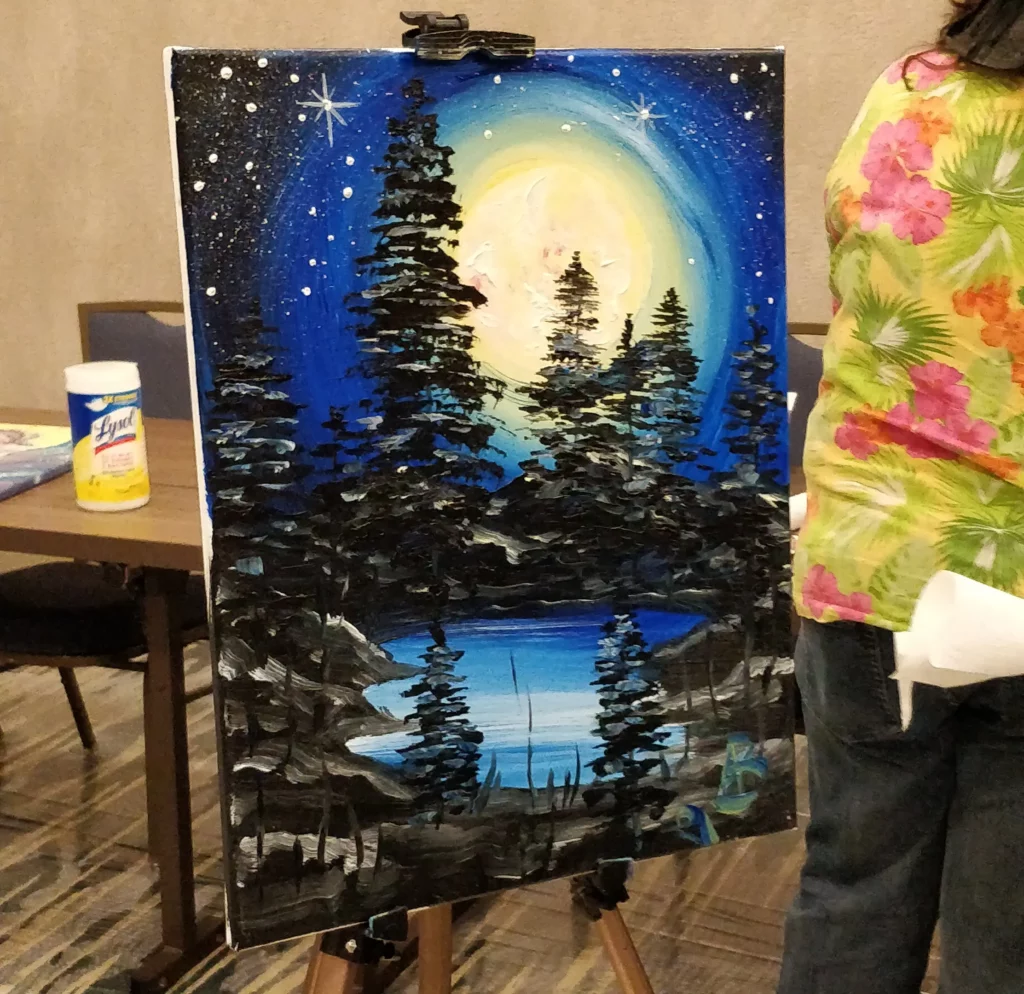
A fun fact about this one: the trees are as large as they are because Amelie accidentally dropped some dark paint in the middle of the moon, and needed something in the foreground to cover it up. She made the Bob Ross reference that she’d simply “put a tree on it.” Later, while attempting to pour quickly, she dropped some paint on herself, joking, “Oh, no, my favorite shirt!” One of the audience members then shouted out the solution, “Put a tree on it!”
Amazingly, Ms. Belcher’s demonstration ran nearly an hour past its ending time– maybe less amazing considering it started half an hour late, but considering I had been legitimately worried about falling asleep after the long weekend, I was surprised the time passed so fast and sad that it was over. I had entirely planned to leave after this demo, as the only event left would be the closing ceremonies, which I didn’t want to kill more time waiting for. Seeing as it was already time for those to start (meaning no time-killing would be necessary), I decided to cap off the weekend by attending, just one more spur-of-the-moment decision to finish off the convention.
Closing Ceremonies (6pm-6:30pm)
The closing ceremonies were the only event I attended within the “Main Events” ballroom. This room was smaller than Hall 1 at RTX in the Austin Convention Center, continuing the “small convention” atmosphere for NDK, but it was much larger than any of the side panel rooms I’d been in previously. While I had a vague idea about this room’s existence, I had to follow those around me to find where the door was, which is surprising given the number of hours I had explored the convention center before this.
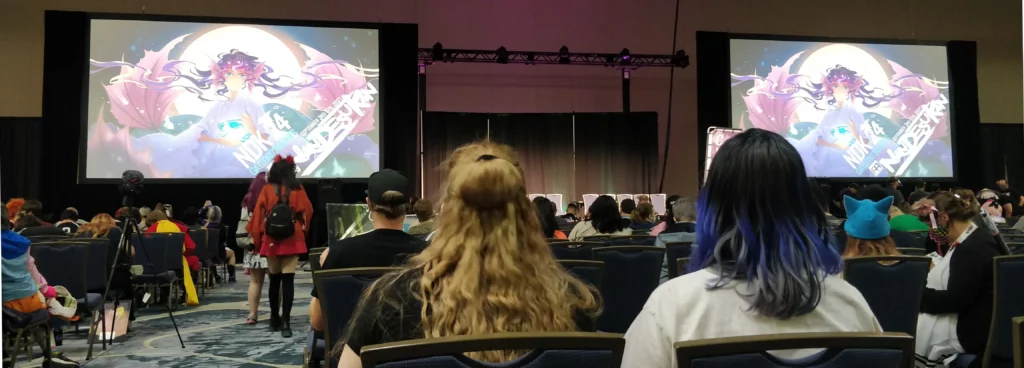
Eventually, a man named Jeremy Pieta took to the stage and began speaking. I hadn’t seen him before this, but I figured out pretty quickly that he was some kind of figurehead for the convention. Jeremy is a board member for the Rocky Mountain Anime Association, and his titles as listed on various websites include Director of Technology, Director of Hospitality, and Co-Director of Staff.
Whatever his official function, I found him to be an excellent speaker for the convention. I quickly went from not knowing him at all to very closely identifying with his passion and excitement about the event and community. Hearing his speech about the meaning of the weekend while thinking about everything I’d seen left me both satisfied and wanting more.
After Jeremy thanked the RMAA board and the 300 staff members who helped run the show, the eight guests of honor were invited onto the stage to say their goodbyes. Finally, Nami Larson, the head of Japanese Guest Services, lead the audience in a Sanbon-jime (三本締め) hand clapping ceremony to officially mark the end of the event.
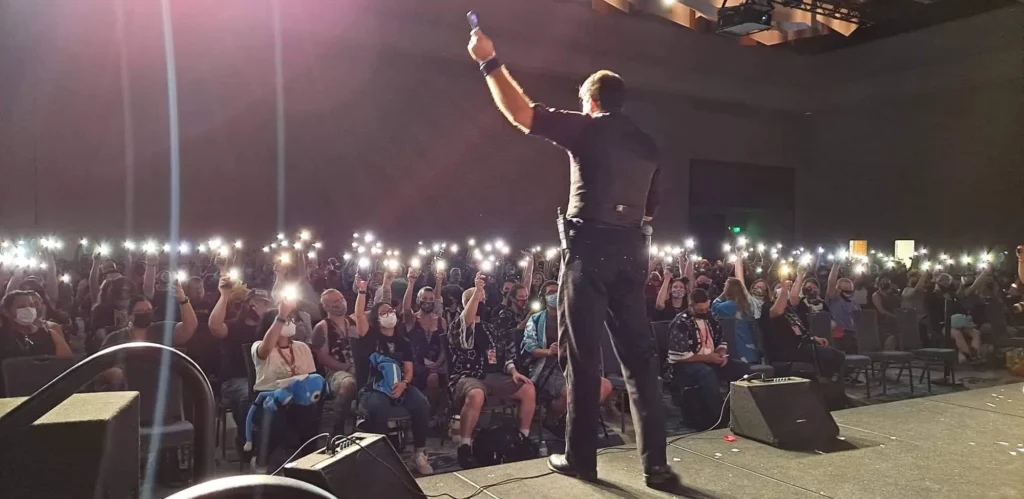
Parting Thoughts & Conclusions
Deciding to attend this convention was a tough decision for me. When I moved to Denver in 2019, I had only ever watched one anime, and I didn’t consider it a part of my daily life. But over the last few years, I’ve found myself using anime and related media to escape from (or even cope with) the real world’s problems.
At the same time, a lot of those problems that I was escaping from were, in my eyes, related to Denver and/or my decision to move here. So while an anime convention might have sounded like a good idea, an anime convention in Denver made me nervous. Would this experience lighten my view of Denver through the enjoyment of anime, or would it tinge my enjoyment of anime through the reality of Denver?
Fortunately, in this specific case, attending turned out to be a great idea– one of the best things I’ve done all year. I enjoyed every single event that I attended, I saw an enormous amount of beautiful artwork, and I didn’t have any negative encounters or witness any unfortunate incidents.
I think the fact that COVID restrictions are still in place played an important part in shaping the demographic of this year’s NDK. On one end of the spectrum, a small amount of attendees who didn’t want to wear masks chose not to attend. But on the other end, a possibly larger amount of people who were worried about contracting and spreading the “delta variant” also chose not to attend.
This means the most polarized groups were underrepresented, and the convention as a whole was less crowded as a result. All of that was a good thing, as it made for a very smooth experience! What remains to be seen is how those demographics will change next year, when governments lift restrictions and media stops laying the coverage on so heavily.
I’m not sure if I’ll enjoy NDK again next year. What I do know is that I enjoyed it this year, and (as of right now) I’ll still be in the area next year. So as of right now, I would recommend this convention, and I am planning to attend again. Who knows, maybe I’ll find someone to attend with next time, or maybe I’ll try a cosplay… we’ll just have to wait and see!

